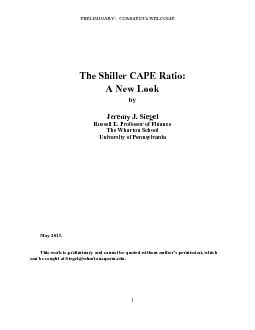

tax NIPA corporate profits are substituted for SP reported reverting In other words when the CAPE ratio was above its long run average the model predicted belowaverage real returns for stocks o ID: 854882
Download Pdf The PPT/PDF document "have been too pessimistic because recent..." is the property of its rightful owner. Permission is granted to download and print the materials on this web site for personal, non-commercial use only, and to display it on your personal computer provided you do not modify the materials and that you retain all copyright notices contained in the materials. By downloading content from our website, you accept the terms of this agreement.
1 have been too pessimistic because recent
have been too pessimistic because recent FASB rulings, particularly mark-to-market rules, have biased Standard and PoorÕs reported earnings tax NIPA corporate profits are substituted for S&P reported reverting. In other words
2 , when the CAPE ratio was above its long
, when the CAPE ratio was above its long run average, the model predicted below-average real returns for stocks over the next decade and the model predicted above-average returns when the CAPE ratio was below its average. The C
3 APE ratio from 1871 through 2012 is plot
APE ratio from 1871 through 2012 is plotted in Figure 1 along with the forecast ten-year real stock returns from the model against attention when the authors .4 reasons Figure 2 plots after-tax per share earnings recorded by
4 three different series: (1) the reporte
three different series: (1) the reported earnings series published by Standard and PoorÕs and used in the Shiller-Campbell analysis, (2) the operating earnings, a companion series also published by Standard and PoorÕs and firs
5 t released in 1989, and (3) real after-t
t released in 1989, and (3) real after-tax corporate profits as published in the national Income and Products accounts adjusted for changes in the number of shares outstanding.6
6 6The actual S&P divisor (published on St
6The actual S&P divisor (published on Standard and PoorÕs website) is used for the period 1988 through 2012. The average change in the divisor is 0.9939% per year and this is extended back to the beginning of the NIPA series in
7 1928. The most comparable NIPA profit s
1928. The most comparable NIPA profit series (as indicated by Hodges, (see footnote 13) are taken from Table 1.12 of the National Income and Product Accounts, line 45 and deflated by the same inflation measure used by Shiller
8 in the CAPE ratio and the S&P divisor de
in the CAPE ratio and the S&P divisor described One can see that the cyclical nature of S&P reported earnings has changed dramatically in the stated that securities of financial institutions held for trading or Òavailable for
9 sale,Ó were required to be carried at f
sale,Ó were required to be carried at fair market value.10 These new accounting standards greatly increased the magnitude and number of write-downs that firms were required to report without making any offsetting allowances
10 for increases in the value of assets tha
for increases in the value of assets that recovered or rose in value he out-sized declines in Standard of PoorÕs reported earnings during the two most recent recession not only differed sharply from its historical The BEA defi
11 nes Òcorporate profitsÓ as the income ea
nes Òcorporate profitsÓ as the income earned from the current production by US corporations based on Òadjusting, supplementing, and integrating financial based and tax-based source data.Ó14 Such data generally excludes the reva
12 luation of assets because revaluations d
luation of assets because revaluations do not apply to the profit flow from current production. market market 14 In particular, tax accounting measures come from the IRS, Statistics of Income (SOI): Corporation Income Tax R
13 eturns. yields (1/CAPE ratio). Of the
eturns. yields (1/CAPE ratio). Of the four regressions, CAPE and 1/CAPE against annualized and total real returns, the regressions of the earning yield against total stock returns consistently yielded the highest R2. Whiche
14 ver formulation is used, substituting S&
ver formulation is used, substituting S&P operating earnings, and particularly NIPA profits into the regression equation not only improves the fit but also Figure 4 their need to float new shares, increased their buyback
15 of existing shares, or reduced other for
of existing shares, or reduced other forms of financing which lower earningsTheoretically, finance theory predicts that every one percentage reduction in the dividend yield should increase the per share earnings growth by one p
16 ercentage point and should not have any
ercentage point and should not have any impact on the real return to shareholders. These conditions have been closely met by the data. Indeed, from before to after World War II per shares earnings growth increased 2.28 perce
17 ntage points from 0.69% to 2.97% at the
ntage points from 0.69% to 2.97% at the same time firms lowered the dividend yield by 1.77 percentage points to 3.27% from 5.04% . Another way of taking into account the change in the post 1945 data is to add a dummy variable
18 to the return forecasting equation. s
to the return forecasting equation. slower real growth. In the steady state, a higher price earnings ratio will lead to lower real returns, but in the transition from a lower to a higher price-earnings ratio will temporaril